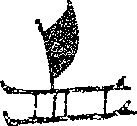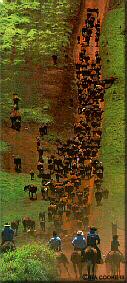ABOUT MOLOKAI – Molokai History

One and a half million years ago, two large volcanoes pushed through the surface of the Pacific Ocean and created the island of Molokai. Kamakou in the east, and Maunaloa in the west. Somewhat later a third and much smaller caldera, Kauhako, popped up to form the Makanalua peninsula on the north side.
Over eons, the north side of the island eroded and fell into the sea, leaving behind the vertical sea cliffs which today make up most of Molokai’s spectacular North Shore.
It’s the fifth largest island in the Hawaiian archipelago; 260 square miles (420 sq km) in area, 38 miles (61km) long, and ten miles (16km) wide at its widest point.
Anchored in the center of the 8 major islands, Molokai is 25 miles (40km) southeast of Oahu, and a 25-minute flight from Maui. From the eastern end of the island, it’s only 8 miles (13km) across the Pailolo Channel to Maui.
The population is estimated at 8,000 residents, half of whom live in or near the principal town of Kaunakakai. Nearly 40% are of Hawaiian descent, thus the nick name, “The Most Hawaiian Island.”
According to the experts, Hawaiians first came to live on Molokai about 650 A.D. Those first settlers most likely originated from the Marquesas, with later migrations, in double hulled canoes, from Tahiti and other areas in the South Pacific.
As the Hawaiians had no written language, most of their pre-contact history has come from chants, passed down from generation to generation, which have kept a chronology of events, battles and genealogy.
In November, 1778, Captain James Cook sighted Molokai on his first visit to the Sandwich Islands, as he named these islands, but it wasn’t until 1786 when Captain George Dixon anchored off Molokai’s coast, that Europeans first visited this island.

In 1832 a Protestant mission was established at Kalua’aha on the East End by Reverend Harvey Hitchcock, to serve an estimated population of 5,000. His church has not been maintained, but the walls and part of the roof stand today at the 14.5 mile marker. A white marble headstone marks his grave on the hill east of what remains of the church.

The oldest known Hawaiian settlement on Molokai occurred in Halawa Valley, at the eastern end of the main highway that crosses the length of the island. The eastern side of the island was heavily populated in pre-contact Hawaii, a result of ample water from the mountains, fertile and level land for farming, and a rich and abundant ocean.
More than 60 fish ponds were built along the south shore of Molokai. Most have nearly disappeared, but a few have been reconstructed and are used daily by residents for aquiculture. A drive along the south
shore of the island bears testimony to the reliance on the ocean by early Hawaiians.
Molokai was renowned for the wisdom and power of its religious leaders, greatly respected and often feared by others in the archipelago. In the 1500s, the famous prophet, Lanikaula, was so revered that pilgrims came from all the Islands to seek his wisdom and advice. Molokai became a place of retreat, protected from war by its religious prestige and the marital alliances of its chiefs.

Others were reputed for sorcery. Legend tells of the Kalaipahoa, or poisonwood gods, entering trees on Maunaloa. The grove is said to have been so poisonous that birds fell dead as they flew over it.
Legend also tells us that Laka, goddess of the hula, gave birth to the dance on Molokai, at a very sacred place in Ka’ana. This is recognized on Molokai every May, at a celebration of the birth of hula, called Ka Hula Piko.
When Laka died, her remains were secretly hidden somewhere beneath the hill, Pu’u Nana. The hula was finally established, the work of Laka was complete, and the dance flourished throughout Hawaii.
Molokai Ranch

In 1897, a group of prominent businessmen formed what is now Molokai Ranch, Ltd. They purchased 70,000 acres of land, mostly on the western half of Molokai, leased another 30,000 acres of government land and began raising cattle and other livestock. Today Molokai Ranch encompasses about 53,000 acres which is roughly one third of the island.
From the beginning, the rich paniolo (Hawaiian cowboy) heritage has been an integral part of the ranch. This is a working cattle ranch with real life cowboys doing real life cowboy chores on a daily basis.
For over 100 years, the ranch has played a major role in the evolution of the island’s agriculture-based economy and in the development of the necessary water resources.
In the early days the focus was on raising beef cattle for market, plus horses and mules for use here and for sales elsewhere. Over time, other ventures were tried with varying degrees of success. Some of these included raising sheep for market, honey production, a small dairy, and various grains and row crops.
Between 1923 and 1985 several thousand acres were leased to Libby and to Del Monte for pineapple cultivation. During those years, pineapple was an economic mainstay for Molokai.
More recently, activities were introduced that allowed Molokai visitors the opportunity to experience authentic ranch life first-hand and to stay at the Lodge or the Beach village at Kaupoa Beach. However, in May 2008, the Ranch ceased all its operations on the island.
The Ranch’s parent company, Molokai Properties Limited, wanted to develop a section of the Ranch’s land at La’au Point on the southwest corner of Molokai. Their stated plan would have created a small sub-division of about 200 multi-million dollar homes.
Opposition from the community arose to the plan. After many heated and sometimes bitter public planning and environmental impact meetings, Molokai Properties decided to abandon the plan. Within a few days, they announced that the Ranch would be ceasing all its operations on Molokai including the Lodge, movie theater, and Kaluakoi Golf Course. They then laid off almost their entire Molokai work force of about 120 employees.
